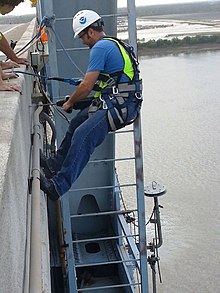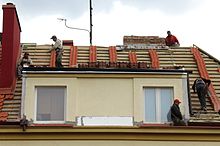| Revision as of 22:24, 5 March 2016 editSanket Edits Wiki (talk | contribs)Extended confirmed users, Pending changes reviewers, Rollbackers1,099 edits Reverted 1 edit by 49.32.32.70 (talk): Missing references. (TW)← Previous edit | Revision as of 07:40, 6 March 2016 edit undo2405:204:8183:5512:55ba:8ff0:8080:fc7d (talk) →Classifications: inspections section updatedNext edit → | ||
| Line 18: | Line 18: | ||
| Class 4 Suspension belts are independent work supports used to suspend a worker, such as boatswain's chairs or raising or lowering harnesses . | Class 4 Suspension belts are independent work supports used to suspend a worker, such as boatswain's chairs or raising or lowering harnesses . | ||
| <ref>https://www.osha.gov/Region7/fallprotection/fall_protection_info.html</ref> | <ref>https://www.osha.gov/Region7/fallprotection/fall_protection_info.html</ref> | ||
| AS per Mr. jwala Sharma (Asian society of safety engineers) following are the check points of a safety harness | |||
| 1 Belt confirming to EN Standard? | |||
| 2 Condition of Lanyard? | |||
| 3 Condition of Spring Hook/ Karabiner? | |||
| 4 Condition of Straps? | |||
| 5 Condition of the Buckles | |||
| 6 Condition of Chest Strap | |||
| 7 Condition of D- Ring | |||
| ==Uses== | ==Uses== | ||
Revision as of 07:40, 6 March 2016


A safety harness is a form of protective equipment designed to protect a person, animal, or object from injury or damage. The harness is an attachment between a stationary and non-stationary object and is usually fabricated from rope, cable or webbing and locking hardware. Some safety harnesses are used in combination with a shock absorber, which is used to regulate deceleration when the end of the rope is reached. One example would be bungee jumping.
In North America, Safety Harness for protection against falls from heights in industrial and construction activities are covered by design performance standards issued by ANSI (American National Standards Institute) in the United States and by CSA (Canadian Standards Association) in Canada. Specifically, the standards issued are ANSI Z359.1 and CSA Z259.10. These standards are updated approximately every four to five years so it is important to ensure the latest version is referenced.
Classifications
Fall Protection Systems
Listed below are different types of fall safety equipment and their recommended usage.
Class 1 Body belts (single or double D-ring) are designed to restrain a person in a hazardous work position to prevent fall or to arrest a fall completely within 3 foot of movement (OSHA). Amends must be made to keep the line rigid at all times. A harness should also be used.
Class 2 Chest harnesses are used when there are only limited fall hazards (no vertical free fall hazard), or for retrieving persons such as removal of persons from a tank or a bin.
Class 3 Full body harnesses are designed to arrest the most severe free falls.
Class 4 Suspension belts are independent work supports used to suspend a worker, such as boatswain's chairs or raising or lowering harnesses .
AS per Mr. jwala Sharma (Asian society of safety engineers) following are the check points of a safety harness
1 Belt confirming to EN Standard? 2 Condition of Lanyard? 3 Condition of Spring Hook/ Karabiner? 4 Condition of Straps? 5 Condition of the Buckles 6 Condition of Chest Strap 7 Condition of D- Ring
Uses
Safety harness types include:
- Seat belts.
- Child safety seats.
- Over-the-shoulder restraints used on roller coaster trains.
- A seat with a full body harness such as used by fighter pilots.
Occupations that may involve the use of safety harnesses include:
- Roofer
- Window washer
- Theatrical fly crew member
- Construction worker
- Crane operator
- Bridge painter
- Lineman
- Rock climber
- Motorsport
- Scaffolder
- Sailing
References
Jones & Bartlett. Fire Fighter Skills. 2nd ed. Boston, Toronto, London, Singapore: Jones and Bartlett Publishers, 2009. pp243-244. Print.
External links
This technology-related article is a stub. You can help Misplaced Pages by expanding it. |